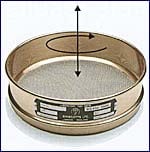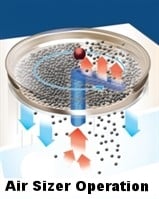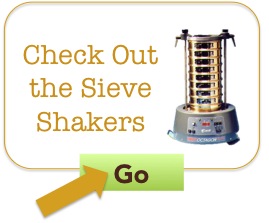If you take Sieve Shakers for granted, you may be surprised to know that the selection of the right shaker can have a profound effect on your sieving results.
To begin with the basics:
Need for a Shaker
The primary purpose of a sieve shaker is to provide motion to a sample  in a test sieve. An effective shaker creates a sieving motion that presents all the particles in a sieve to all of the sieve openings and assists particles to pass through the sieve openings.
in a test sieve. An effective shaker creates a sieving motion that presents all the particles in a sieve to all of the sieve openings and assists particles to pass through the sieve openings.
A combination of rotary and vertical motion will usually achieve that objective.
This concept of sieve shaking began with early Egyptians when they sieved grain. Later instructions for manually sieving become more detailed. The following process prescribed by ASTM.
A sieve or stack of several sieves is cradled loosely in a slightly inclined position in the crook of the arm. The sieves are tapped at the rate of approximately 120 times per minute with the flat of the hand. After about 30 taps, the sieves are put into a horizontal positioned and given a sharp vertical shake and a hard tap.
If This sounds to you like a tedious process --- You’re right. That’s why mechanical sieve shakers were invented.
Evolution of Sieve Shakers
The first me chanical sieve shakers were designed to closely duplicate this process. The developers coined the name RoTapP™ for rotation and tapping. These shakers were effective but were exceedingly loud. Shakers with designs fundamentally unchanged from the original, with names such as RoTap™ and DuraTap™, are widely used today.
chanical sieve shakers were designed to closely duplicate this process. The developers coined the name RoTapP™ for rotation and tapping. These shakers were effective but were exceedingly loud. Shakers with designs fundamentally unchanged from the original, with names such as RoTap™ and DuraTap™, are widely used today.
In the beginning sample sizes were about what can fit into a large coffee mug. Manual sieving ,though tiresome was possible using 8” (200mm) sieves. This was the size adopted for the early shakers.
The application of sieving for particle size analysis expanded bringing extended requirements for:
- Small sample sizes due to expensive material or very fine samples
- Large sample sizes up to 40 LB (20kg) in applications such as construction and mining
- Processing material with a tendency to clump or agglomerate
- Handling low density material that tended to fly over the sieve mesh
- Separating fine material with particles below 30 microns
These requirements set the stage for the development of many specialized shakers. With the advent of these new shakers, the need to evaluate performance characteristics was a development. Selection of the optimum shaker was a necessary consideration to meet the new criteria and specifications of changing samples.
Along with these requirements designers of the next generation of shakers began to deal with other problems. Among these are noise, agglomeration, changing sample size patterns and special characteristics of small micron size particles..
Noise
Electromechanical designs, rather than mechanical rotating and banging, were introduced to deal with appalling noise problems. Noise so deafening it cleared a la boratories when sieving was in process. A modern electromechanical shaker can be used in a normal laboratory setting without the need for ear protection or sound proof enclosures.
boratories when sieving was in process. A modern electromechanical shaker can be used in a normal laboratory setting without the need for ear protection or sound proof enclosures.
Agglomeration
 In dealing with clumping (agglomeration or electrostatic)problems, developers found that wet sieving could over come many of the more difficult problems and developed shakers that would safely operate with water flowing through the sieve stack.
In dealing with clumping (agglomeration or electrostatic)problems, developers found that wet sieving could over come many of the more difficult problems and developed shakers that would safely operate with water flowing through the sieve stack.
Other solutions included jolting the sample through sudden starting and stopping, using ultra sonic agitators on the sieves, and applying air to break up the clumps.
Small Sample Size
A small sample in too large a diameter sieve leads to inconsistent results. The 3” (100mm) diameter sieve solved some of these problems. Of course modification of shakers were needed to accommodate these small sieves.
Samples Requiring 12” ( mm) or 18” ( mm)
At the other end of the requirement is the need, in several industries, to do test sieving with large samples. Some material and some standards require 20 lb. (10kg) to 40 lb. (20kg) of sample. A robust design is called for that must still create a motion that exposes all the particles to all the apertures in the sieve.
Small Particle Size
 Requirements for separation of particles down below 50 microns pose special difficulties. Unique methods have been put together. it’s necessary insure that the small particles get through the sieve opening and are not be blocked by over sized particles closing apertures (blinding). Similarly, clumps must be broken up (electrostatic clumping becomes more and more of a problem as the particles get smaller). in addition, flying light weight particles, that never touch the sieve mesh, can become significant with these small sizes.
Requirements for separation of particles down below 50 microns pose special difficulties. Unique methods have been put together. it’s necessary insure that the small particles get through the sieve opening and are not be blocked by over sized particles closing apertures (blinding). Similarly, clumps must be broken up (electrostatic clumping becomes more and more of a problem as the particles get smaller). in addition, flying light weight particles, that never touch the sieve mesh, can become significant with these small sizes.
Solutions
Consideration of the special needs of each test sample is essential when selecting a sieve shaker. Because we handle shakers that cover the full gamut of these variables, we are sensitive to these special needs when evaluating a sieve shaker. The optimum shaker ensures good, reliable and repeatable sieve test results.
To more easily delineate the main issues in determining the best shaker, we have divided the units into three categories.
This category includes shakers that handle the simpler product and require 3” (100 mm) and 8” (200 mm) sieves and up to 6 lb.. of sample. The category also includes items that have capability to break up agglomerates and perform the wet sieving process. These shakers are quiet and can comfortably run sieve tests while not disturbing other lab functions.
Heavy duty shakers include the noisy mechanical Rotate and Tap machines that operate with smaller samples and a mechanical cam and motor device that can deliver good results with 12” sieves and  more than 10 lb. of sample.
more than 10 lb. of sample.
There are two other machines in this category that
- use quiet electromechanical drives
- deal with up to 20 and 40 pounds
- accommodate up to 12” and 18” sieves
- can operate the wet sieving process.
These modern designs effectively deal with most sample problems such as agglomeration, electro-static clumping and blinding for all but the very small particle separations.
Small Particle Separation Down to 3 microns
For some test samples a modern design, general purpose shaker can deliver consistent results down to 20 Microns. However, when the test sample for these very small particle exhibit the special problems we described, different techniques are needed.
 One of these is to apply both a vertical sweep of air from below the sieve to push up blinding particles and at the same time apply a vacuum to pull the particles through the sieve and eliminate flying pieces. The limitation of this method is that you can only perform one separation or sieve at a time.
One of these is to apply both a vertical sweep of air from below the sieve to push up blinding particles and at the same time apply a vacuum to pull the particles through the sieve and eliminate flying pieces. The limitation of this method is that you can only perform one separation or sieve at a time.
Another methods is use a combination of a stream of high frequency air and a mechanical shock to get the desired result. These units can do up to six separations per test run.
The lower limit of particle size analysis with techniques that push the particles through hole is a mesh is about 3 Microns. Other techniques are used below that.
One of the commonly used methods for small particle analysis is Laser Diffraction. In this technique a laser beam is deflected by the particles. This deflection is measured and particle size dispersion is calculated. There are also several other method of small particle analysis.
Summary
I hope that this rant about sieve shakers does two things. First, you will get a sense that the selection of the best sieve shaker for your application needs to consider several factors. Second,that it further demonstrates why I am frequently sand bagged by unexpected detail/complications of the test equipment business.
Please share this with any colleagues who might find it interesting and useful.
I remain as confused as ever.
Art
P. S. If you would like to be informed by email of our next harangue, subscribe in the space above with your email.


